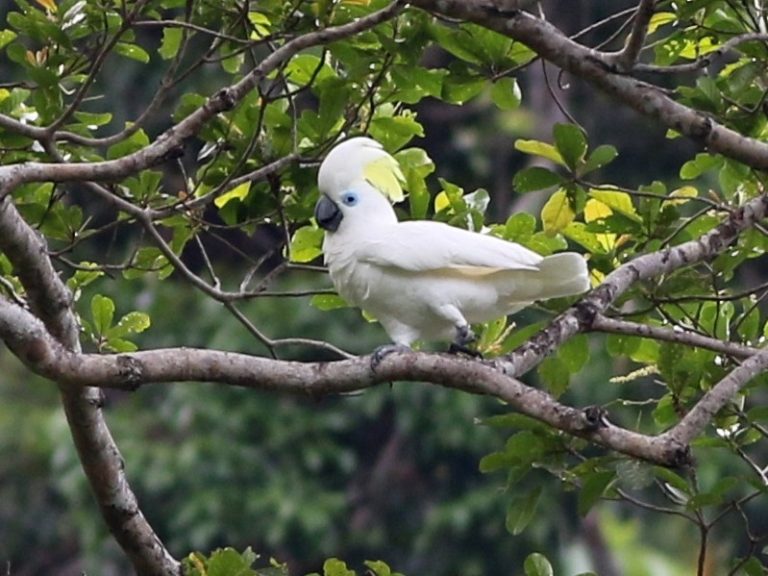Birdfinding.info ⇒ Like other forest-dependent endemics of New Britain, this charismatic species is threatened by the widespread conversion of that island’s native forests to palm oil plantations. However, it apparently tolerates habitat disturbance well enough to remain locally common. Sites where it can be found consistently include Garu and Pokili Wildlife Management Areas, Mount Tarbuna, and Walindi.
Blue-eyed Cockatoo
Cacatua ophthalmica
Endemic to New Britain, where it occurs throughout the island in humid lowland and foothill forests up to around 1,000 m elevation.
Identification
A large white cockatoo with powder-blue “goggles” (orbital skin) and a luxuriant yellow-and-white crest: a white shield with pale-yellow feathers behind it. Unique in its limited range, so unlikely to be mistaken for any other species.
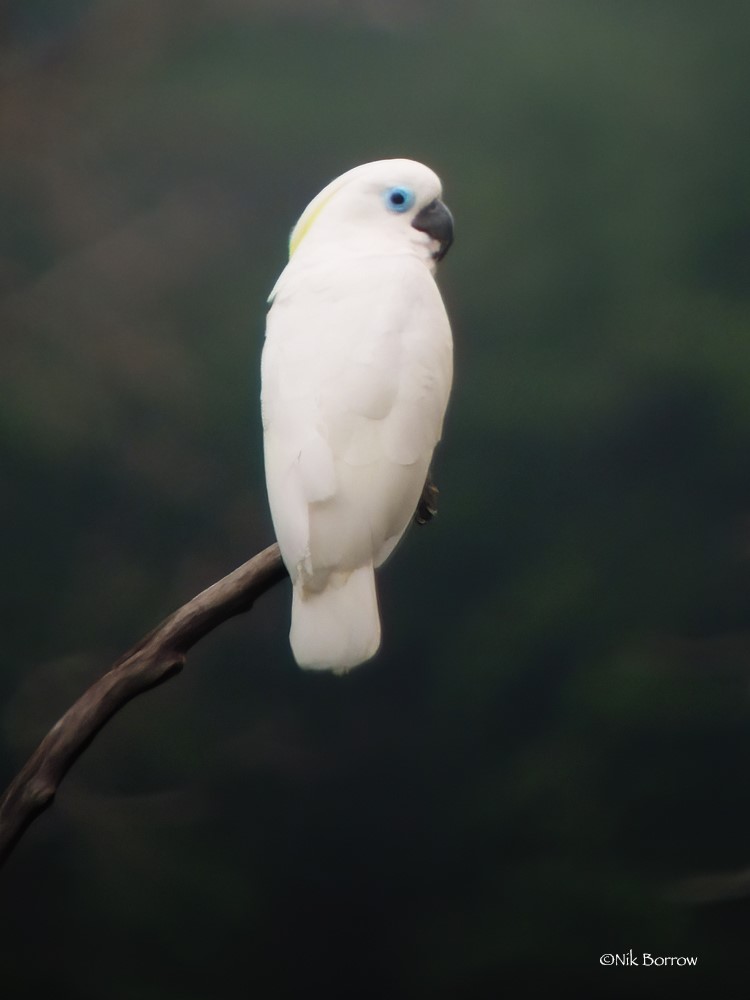
Blue-eyed Cockatoo. (New Britain, Papua New Guinea; August 2012.) © Nik Borrow
At rest, the white shield mostly or entirely obscures the yellow feathers, so it can appear all-white under some conditions.
As on other white cockatoos, the undersides of the wings and tail are suffused with a powder-yellow wash.

Blue-eyed Cockatoo, pair. (New Britain, Papua New Guinea.) © Jonathan Rossouw

Blue-eyed Cockatoo with plumage puffed out, apparently in display. (New Britain, Papua New Guinea; August 2014.) © Markus Lilje

Blue-eyed Cockatoo. (Mount Vege, Haella, New Britain, Papua New Guinea; July 21, 2018.) © Sue Wright

Blue-eyed Cockatoo. (Kilu Ridge, New Britain, Papua New Guinea; August 9, 2014.) © Markus Lilje

Blue-eyed Cockatoo. (Gusi, New Britain, Papua New Guinea; September 16, 2019.) © Sue Hacking
Voice. Typical calls are hoarse, guttural barks or milder, trumpet-like honks, given in series: Garu Wildlife Management Area, New Britain, Papua New Guinea; August 2, 2009. © Pamela C. Rasmussen
Notes
Monotypic species.
IUCN Red List Status: Vulnerable.
See below for a comparison of Blue-eyed Cockatoo with White Cockatoo. (For comparison with other similar forms, see Identification of Yellow-crested Cockatoos.)
Cf. White Cockatoo. Blue-eyed and White Cockatoos are approximately the same size and overall coloration, with two noticeable differences: blue versus white orbital skin and the presence or absence of pale-yellow in the crest.
They do not occur together naturally, but both are popular cagebirds that could occur anywhere (climate permitting). Moreover, White has reportedly hybridized with Sulphur-crested, which could potentially produce offspring with the same coloration as Blue-eyed—such hybrids remain a hypothetical possibility, but should be considered in case of any out-of-range individuals that appear to be Blue-eyed.
Additional Photos of Blue-eyed Cockatoo

Blue-eyed Cockatoo. (Mount Vege, Haella, New Britain, Papua New Guinea; July 21, 2018.) © Sue Wright

Blue-eyed Cockatoo. (Garu Wildlife Management Area, New Britain, Papua New Guinea; September 13, 2019.) © Chris Wiley
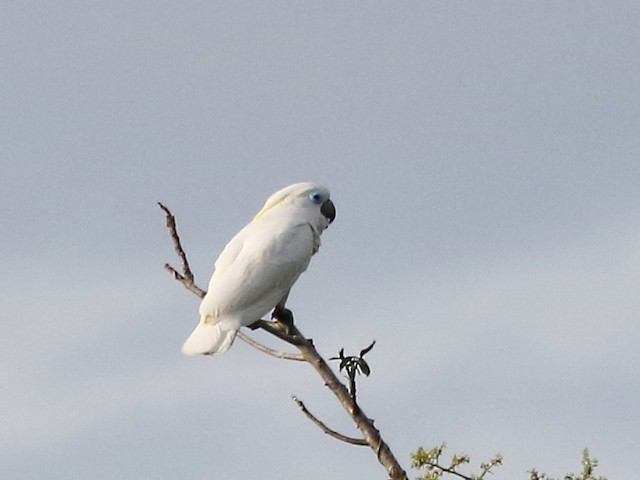
Blue-eyed Cockatoo. (Garu Wildlife Management Area, New Britain, Papua New Guinea; July 24, 2017.) © Myles McNally
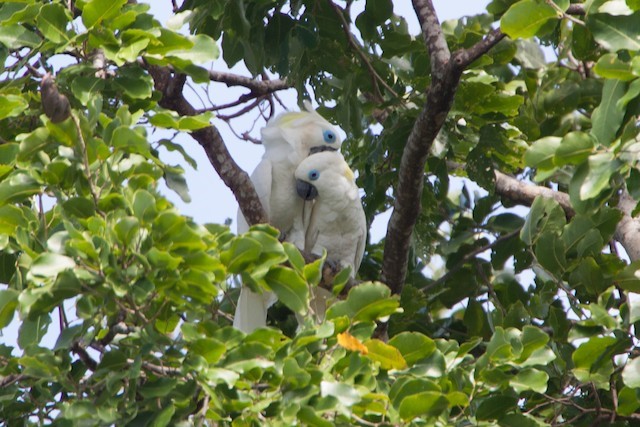
Blue-eyed Cockatoo, pair. (Pokili Wildlife Management Area, New Britain, Papua New Guinea; September 17, 2005.) © Simon Colenutt

Blue-eyed Cockatoo. (Garu Wildlife Management Area, New Britain, Papua New Guinea; September 11, 2019.) © Stephan Lorenz
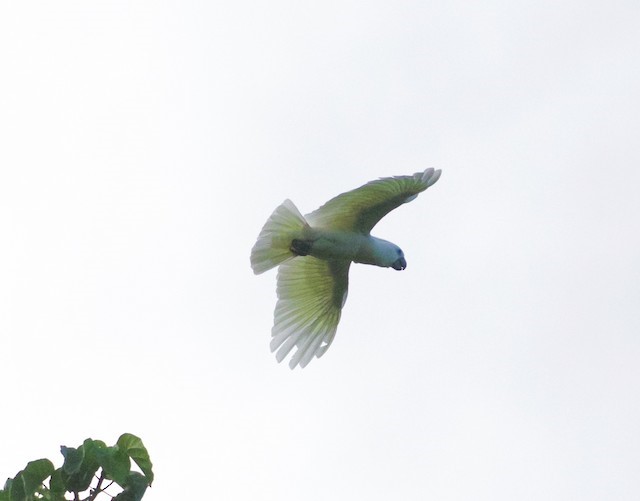
Blue-eyed Cockatoo. (Garu Wildlife Management Area, New Britain, Papua New Guinea; September 16, 2019.) © Scott Baker
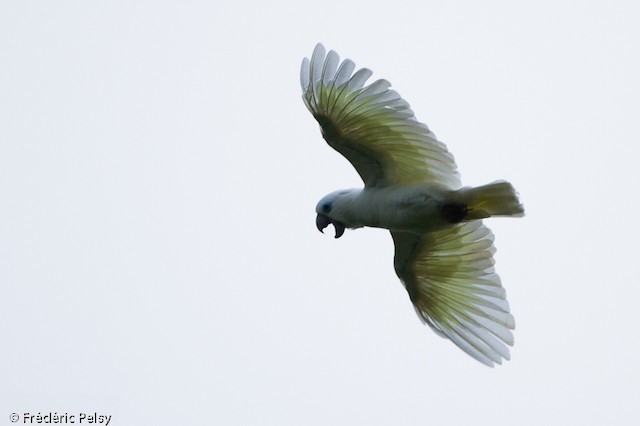
Blue-eyed Cockatoo. (Garu Wildlife Management Area, New Britain, Papua New Guinea; October 1, 2014.) © Frédéric Pelsy
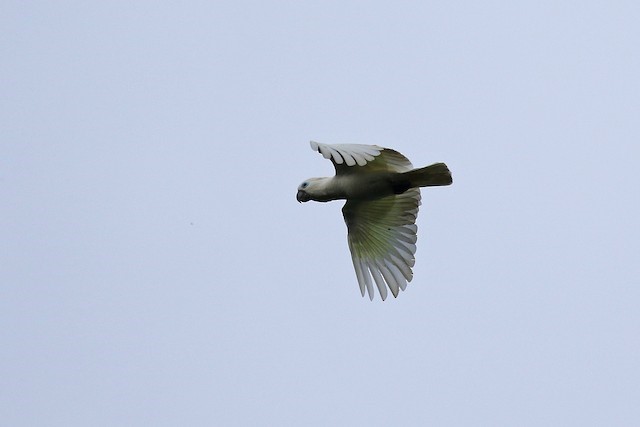
Blue-eyed Cockatoo. (Mount Garbuna, New Britain, Papua New Guinea; June 16, 2018.) © Brendan Ryan
References
BirdLife International. 2018. Cacatua ophthalmica. The IUCN Red List of Threatened Species 2018: e.T22728429A132032417. https://dx.doi.org/10.2305/IUCN.UK.2018-2.RLTS.T22728429A132032417.en. (Accessed August 5, 2021.)
eBird. 2021. eBird: An online database of bird distribution and abundance. Cornell Lab of Ornithology, Ithaca, N.Y. http://www.ebird.org. (Accessed August 5, 2021.)
Forshaw, J.M. 2010. Parrots of the World. Princeton University Press.
Juniper, T., and M. Parr. 1998. Parrots: A Guide to Parrots of the World. Yale University Press.
Michigan State University. 2021. AVoCet: Avian Vocalizations Center. https://avocet.integrativebiology.natsci.msu.edu/. (Accessed August 5, 2021.)
